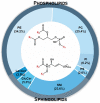Cardiometabolic health benefits of dairy-milk polar lipids
- PMID: 34879146
- PMCID: PMC8653938
- DOI: 10.1093/nutrit/nuab085
Cardiometabolic health benefits of dairy-milk polar lipids
Abstract
Low-quality dietary patterns impair cardiometabolic health by increasing the risk of obesity-related disorders. Cardiometabolic risk relative to dairy-food consumption continues to be a controversial topic, due to recommendations that endorse low-fat and nonfat dairy foods over full-fat varieties despite accumulated evidence that does not strongly support these recommendations. Controlled human studies and mechanistic preclinical investigations support that full-fat dairy foods decrease cardiometabolic risk by promoting gut health, reducing inflammation, and managing dyslipidemia. These gut- and systemic-level cardiometabolic benefits are attributed, at least in part, to milk polar lipids (MPLs) derived from the phospholipid- and sphingolipid-rich milk fat globule membrane that is of higher abundance in full-fat dairy milk. The controversy surrounding full-fat dairy food consumption is discussed in this review relative to cardiometabolic health and MPL bioactivities that alleviate dyslipidemia, shift gut microbiota composition, and reduce inflammation. This summary, therefore, is expected to advance the understanding of full-fat dairy foods through their MPLs and the need for translational research to establish evidence-based dietary recommendations.
Keywords: dairy milk; milk fat globule membrane; milk phospholipids; milk polar lipids; milk sphingomyelin.
© The Author(s) 2021. Published by Oxford University Press on behalf of the International Life Sciences Institute.
Figures



Similar articles
-
Whole-Milk Dairy Foods: Biological Mechanisms Underlying Beneficial Effects on Risk Markers for Cardiometabolic Health.Adv Nutr. 2023 Nov;14(6):1523-1537. doi: 10.1016/j.advnut.2023.09.001. Epub 2023 Sep 7. Adv Nutr. 2023. PMID: 37684008 Free PMC article. Review.
-
Whole milk dairy foods and cardiometabolic health: dairy fat and beyond.Nutr Res. 2024 Jun;126:99-122. doi: 10.1016/j.nutres.2024.03.010. Epub 2024 Mar 21. Nutr Res. 2024. PMID: 38669850 Review.
-
Alleviation of Metabolic Endotoxemia by Milk Fat Globule Membrane: Rationale, Design, and Methods of a Double-Blind, Randomized, Controlled, Crossover Dietary Intervention in Adults with Metabolic Syndrome.Curr Dev Nutr. 2020 Jul 25;4(9):nzaa130. doi: 10.1093/cdn/nzaa130. eCollection 2020 Sep. Curr Dev Nutr. 2020. PMID: 32885133 Free PMC article.
-
Effects of Full-Fat and Fermented Dairy Products on Cardiometabolic Disease: Food Is More Than the Sum of Its Parts.Adv Nutr. 2019 Sep 1;10(5):924S-930S. doi: 10.1093/advances/nmz069. Adv Nutr. 2019. PMID: 31518411 Free PMC article.
-
Comprehensive Review of the Impact of Dairy Foods and Dairy Fat on Cardiometabolic Risk.Adv Nutr. 2016 Nov 15;7(6):1041-1051. doi: 10.3945/an.115.011619. Print 2016 Nov. Adv Nutr. 2016. PMID: 28140322 Free PMC article. Review.
Cited by
-
Milk-Fat-Globule-Membrane-Enriched Dairy Milk Compared with a Soy-Lecithin-Enriched Beverage Did Not Adversely Affect Endotoxemia or Biomarkers of Gut Barrier Function and Cardiometabolic Risk in Adults with Metabolic Syndrome: A Randomized Controlled Crossover Trial.Nutrients. 2023 Jul 23;15(14):3259. doi: 10.3390/nu15143259. Nutrients. 2023. PMID: 37513677 Free PMC article. Clinical Trial.
-
The Role of Lipids in the Regulation of Immune Responses.Nutrients. 2023 Sep 7;15(18):3899. doi: 10.3390/nu15183899. Nutrients. 2023. PMID: 37764683 Free PMC article. Review.
-
Polar lipids modify Alzheimer's Disease pathology by reducing astrocyte pro-inflammatory signaling through platelet-activating factor receptor (PTAFR) modulation.Lipids Health Dis. 2024 Apr 20;23(1):113. doi: 10.1186/s12944-024-02106-z. Lipids Health Dis. 2024. PMID: 38643113 Free PMC article.
-
The association between dietary quality scores with C-reactive protein and novel biomarkers of inflammation platelet-activating factor and lipoprotein-associated phospholipase A2: a cross-sectional study.Nutr Metab (Lond). 2023 Sep 12;20(1):38. doi: 10.1186/s12986-023-00756-x. Nutr Metab (Lond). 2023. PMID: 37700354 Free PMC article.
-
Whole-Milk Dairy Foods: Biological Mechanisms Underlying Beneficial Effects on Risk Markers for Cardiometabolic Health.Adv Nutr. 2023 Nov;14(6):1523-1537. doi: 10.1016/j.advnut.2023.09.001. Epub 2023 Sep 7. Adv Nutr. 2023. PMID: 37684008 Free PMC article. Review.
References
-
- Younossi Z, Anstee QM, Marietti M, et al. Global burden of NAFLD and NASH: trends, predictions, risk factors and prevention. Nat Rev Gastroenterol Hepatol. 2018;15:11–20. - PubMed
-
- Standl E, Khunti K, Hansen TB, et al. The global epidemics of diabetes in the 21st century: current situation and perspectives. Eur J Prev Cardiol. 2019;26:7–14. - PubMed
-
- Virani SS, Alonso A, Benjamin EJ, et al. ; American Heart Association Council on Epidemiology and Prevention Statistics Committee and Stroke Statistics Subcommittee. Heart disease and stroke statistics-2020 update: a report from the American Heart Association. Circulation. 2020;141:e139–e596. - PubMed
-
- Drewnowski A. The Nutrient Rich Foods Index helps to identify healthy, affordable foods. Am J Clin Nutr. 2010;91:1095S–1101S. - PubMed
Publication types
MeSH terms
LinkOut - more resources
Full Text Sources

